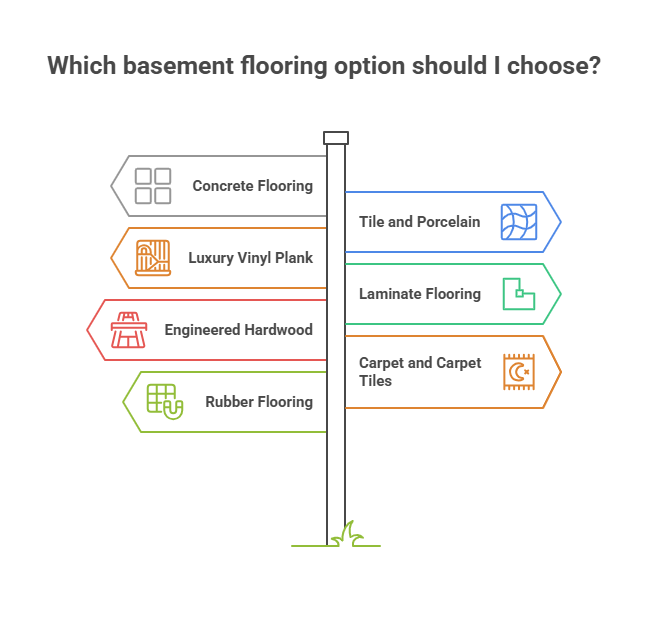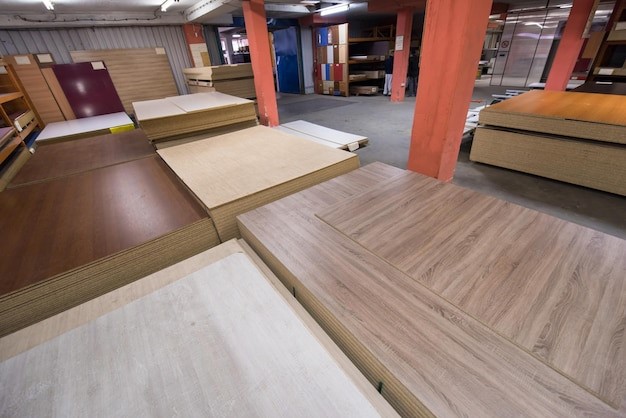When planning a basement renovation, selecting the right basement flooring options can make a significant difference between a damp, cold, unfinished cellar and a warm, welcoming living space. You want floors that withstand moisture, look great, and suit your needs, even for a playroom, home theater, or guest space.
This article walks you through the common choices and helps you pick the best material for your basement. I’ll explain pros and cons, recommend styles that work well underground, and include smart tips you can use.
Different Basement Flooring Options

Concrete Flooring and Sealed Concrete
Concrete is the most common material used in most basements. It is durable and resistant to rot and pests. However, untreated concrete feels cold and is prone to cracking. A good upgrade is to apply a concrete sealer or epoxy coating, which resists moisture and gives a cleaner look. You can tint the concrete before sealing to add color. Sealed concrete is a low-maintenance, cost-effective option that works best when your basement stays fairly dry and well-ventilated.
Tile and Porcelain Options
Ceramic or porcelain tile does well below grade. It handles moisture well, is easy to clean, and offers a variety of styles. The key is to use a proper underlayment or decoupling membrane to absorb minor movement and prevent cracks. Tile provides a high-end look, especially in areas such as basement bathrooms, laundry rooms, or guest baths. It’s rigid, so the subfloor must be solid and level before installing tile.
Luxury Vinyl Plank or Vinyl Tile
Vinyl is one of the most popular basement flooring options nowadays. Luxury Vinyl Plank (LVP) or luxury vinyl tile is resistant to water, fairly flexible, and feels warmer underfoot than bare concrete. It comes in click-together styles or glue-down. Since it can tolerate some moisture, it often works well in basements with mild dampness. Installation is relatively quick, and it offers realistic wood or tile aesthetics. For many renovators, vinyl is a good balance of price, durability, and style.
Laminate Flooring
Laminate is less ideal for basements than vinyl because it uses a fiberboard core that swells if exposed to water. But newer “water-resistant” or “moisture-tolerant” laminates mitigate that risk. You must install a moisture barrier under the laminate. If your basement is already dry and stays dry, laminate can give the look of hardwood, but at a lower cost. Still, always check manufacturer specs for basement use.
Engineered Hardwood
Solid hardwood is rarely recommended in basements, but engineered hardwood offers a more stable structure. Engineered wood utilizes layers of plywood beneath a real wood veneer, providing greater resistance to humidity fluctuations. Still, you should only use engineered hardwood in basements with good moisture control, a proper subfloor, and a vapor barrier. It balances the warmth and elegance of wood with somewhat better stability.
Carpet and Carpet Tiles
Carpet brings softness and sound absorption to a basement. But plain wall-to-wall carpet is risky in humid or damp spaces because mold and mildew can grow underneath. A safer option is to use carpet tiles specifically designed for basements, which can be easily lifted and dried in the event of flooding or moisture.
Rubber Flooring or Foam Tiles
Rubber or interlocking foam floor tiles are ideal for use in home gyms, playrooms, or hobby basements. They resist moisture, cushion footfall, and are easy to replace. They aren’t always classy in appearance for formal living spaces, but they shine in functional zones. Rubber is durable, resistant to molding, and can withstand occasional dampness if installed properly over a suitable subfloor.
How to Choose the Best Materials and Styles
Assess Moisture, Climate, and Insulation
Your first task is to evaluate moisture risk and insulation. If your basement leaks or sweats, choose materials that resist water and can dry out, like vinyl, tile, or sealed concrete. At Georgia Best Home Builders, we emphasize the importance of proper waterproofing and insulation before finishing basements, ensuring that your subfloor and slab are dry, sealed, and stable.
Match Flooring to Room Function
Ask how you’ll use each area. A playroom needs cushioning, while a home theater or guest space favors elegant surfaces. For high-traffic areas, vinyl or tile is the best choice. For a cozy nook, consider carpet tiles or engineered wood. In a bathroom or laundry area, tile or waterproof vinyl is the safest option.
Style and Aesthetic Choices
Wood-look remains popular, so wood-look vinyl or engineered hardwood provides warmth without the moisture risk. Tile patterns, grout lines, and color choices let you replicate classic homes below grade. If you prefer a minimalist, modern style, consider polished concrete or large-format tile. If you choose a cozy, traditional style, wood tones and warm carpets suit you best. Use accent borders or inlays in tile to break monotony.
Budget and Longevity
Vinyl and carpet tiles tend to be less expensive (in terms of both materials and labor), while tile and engineered wood cost more. However, a poor flooring choice that fails due to moisture is more expensive in the long run. Consider the total life cost, including installation, maintenance, and replacement risk. If you stay on budget, you might opt for a mid-range vinyl, paired with good subfloor preparation. On a tight budget, even a simple bathroom design can start with basic waterproof vinyl or tile in wet zones.
Transition and Edge Treatments
Plan edge transitions between materials to avoid tripping hazards. Use proper trim or reducers between carpet and tile, or between subfloor levels. Keep expansion gaps where materials meet walls. Good transitions help longevity and visual flow.
Professional Installation Consideration
Hiring professionals helps reduce mistakes in sealing, leveling, and moisture barrier installation. Integrating proper drain systems, vapor barriers, and framing before the flooring goes in avoids long-term problems. You can contact us to avail yourself of our basement remodeling services.
FAQs About Basement Flooring Options
1. What is the best material for basement floors?
It depends on your moisture conditions and use. If your basement stays dry, vinyl, tile, or engineered hardwood flooring often remains in place. In wet basements, sealed concrete or waterproof vinyl is a safer option. Focus on moisture resistance, ease of cleaning, comfort, and appearance.
2. How to choose the right type of flooring for my basement?
Start by testing moisture levels and spotting damp spots. Decide how you’ll use the space (living, gym, playroom). Match material features (water resistance, insulation, comfort) to use. Then choose the styles and colors you like. Always prep the subfloor well.
3. Which is better for my basement, vinyl or laminate?
Vinyl typically beats laminate for basements because vinyl tolerates moisture better. Laminate’s fiberboard core can swell if damp. Some water-resistant laminates perform well in dry basements, but vinyl gives you more peace of mind in below-grade spaces.
4. How to modernize a bathroom on a budget?
You can pick a stylish waterproof vinyl tile or ceramic tile in affordable designs and change fixtures, lighting, and trim. A regrout or new tile layout can transform the space affordably. Even with a tight budget, focusing on clean surfaces and smart contrast makes a big difference.
Conclusion
When planning your project, consider experienced partners for complex work, such as footing, waterproofing, and framing. You deserve a basement you’ll love. If you feel stuck or need skilled help, Georgia Best Home Builders offers reliable guidance in basement remodels. Share your floor plans and ask for advice. Let us help you create your new space with ease.


